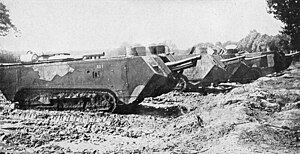Saint-Chamond (tank)
| Saint-Chamond | |
|---|---|

Early model Saint-Chamond
|
|
| Place of origin | France |
| Specifications | |
| Weight | 23 tonnes |
| Length | 8.9 m |
| Width | 2.7 m |
| Height | 2.4 m |
| Crew | 8 (commander-driver, gunner-loader, assistant gunner, four machine gunners, mechanic) |
|
|
|
| Armor | 11–19 mm |
|
Main
armament |
75 mm gun |
|
Secondary
armament |
Four 8 mm Hotchkiss M1914 machine guns |
| Engine | 4-cylinder Panhard-Levassor (petrol) 90 hp (70 kW), Crochat-Colardeau electric transmission |
| Power/weight | 4 hp/tonne |
| Suspension | Coil spring |
| Speed | 12 km/h |
The Saint-Chamond, named after the commune of Saint Chamond, was the second French heavy tank of the First World War, with 400 manufactured from April 1917 to July 1918. Although not a tank by the present-day definition, it is generally accepted and described as such in accounts of early tank development. Born of the commercial rivalry existing with the makers of the Schneider CA1 tank, the Saint-Chamond was an underpowered and fundamentally inadequate design. Its principal weakness was the Holt "caterpillar" tracks. They were much too short in relation to the vehicle's length and heavy weight (23 tons). Later models attempted to rectify some of the tank's original flaws by installing wider and stronger track shoes, thicker frontal armour and the more effective 75mm Mle 1897 field gun. Altogether 400 Saint-Chamond tanks were built including 48 unarmed caisson tanks. The Saint-Chamond tanks remained engaged in various actions until October 1918, belatedly becoming more effective since combat had moved out of the trenches and onto open ground. Eventually the Saint-Chamond tanks were scheduled to be entirely replaced by imported British heavy tanks.
In January 1915, the French arms manufacturer Schneider sent out its chief designer, Eugène Brillié, to investigate tracked tractors from the American Holt Company, at that time participating in a test programme in England. The original French project was to provide mobility to mechanical wire-cutting machines of the Breton-Pretot type. On his return Brillié, who had earlier been involved in designing armoured cars for Spain, convinced the company management to initiate studies on the development of a Tracteur blindé et armé ("armoured and armed tractor"), based on the Baby Holt chassis, two of which were ordered.
Experiments on the Holt caterpillar tracks started in May 1915 at the Schneider plant with a 75 hp wheel-steered model and the 45 hp all-caterpillar Baby Holt, showing the superiority of the latter. On 16 June, new experiments followed in front of the President of the French Republic, and on 10 September for Commander Ferrus, an officer who had been involved in the study (and ultimate abandonment) of the Levavasseur tank project in 1908.
...
Wikipedia
